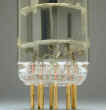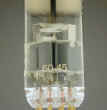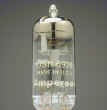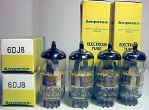 |
 |
 |
 |
photo 1 |
photo 2 |
photo 3 |
photo 4 |
Physical structure of the 6DJ8 tubes
The late 1950’s and early to mid ‘60s tubes in this family had a unique internal structure. Starting at the bottom of the tube and working our way up, first we find the wiring leading up from the pins to the tube’s internal structures (view photo 1). Next is the lower mica spacer it’s a horizontal round disc of mica. This can be round with a serrated or scalloped edge (like a Siemens), or kind of a smooth edge disc with a slightly square shape with rounded corners (like on an Amperex or Sovtek). On top of this are the two vertically oriented plate structures. In this tube type the plates always seem to be painted grey. On top of the plates is the upper mica spacer its just like the lower mica spacer (view photo 2). Up to this point I’ve just described 90% of the 9 pin miniature triodes in the world it’s above this point that things differ. The next structure up is the unique one it’s a horizontal, circular, metal disc supported by two metal bars. I’ve seen & heard this referred to as a shield or a splatter shield. Which name is correct & what is the purpose of this structure? I don’t know, but most all early 6DJ8 family tubes have it. Above this is the getter halo. The halo is usually a metal ring supported by a single metal bar. On some tubes, like very early Amperexes, the getter halo isn’t a ring but instead is a two part metal structure made from wire in the trough shape of the letter D. Tubes with this type getter halo are commonly referred to as D getters (view photo 3). You will often find a different internal structure in what are apparently late production 6DJ8 family tubes from the mid/late ‘60s through the ‘70s. These tubes sometimes had a simplified internal structure that eliminated the splatter shield / getter halo arrangement. In these tubes two metal bars angle up from the upper mica spacer, almost to a point, with a small metal disc on top. Viewed from the side this metal structure on top of the upper mica spacer looks a bit like the letter A hence the nickname A frame (view photo 4). The other exceptions are some late Siemens 6922s & 7308s that just have a single metal rod rising above the upper mica spacer with a ring shaped getter halo on top a practice copied in the Russian 6922s and 6H23Ns.